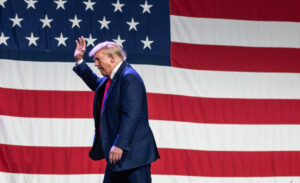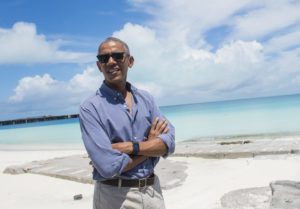F. Scott Fitzgerald wrote that “the test of a first-rate intelligence is the ability to hold two opposed ideas in the mind at the same time, and still retain the ability to function”. His formula is justifiably famous, but it’s worth noting that it comes from an autobiographical essay titled “The Crack-Up”, which painfully detailed Fitzgerald’s inability to pass his own test, and resulting descent into alcoholic dysfunction.
Today’s American crack-up springs from similar sources. Imagine a time-traveller from any decade in recent memory arriving in America in January 2024: they would encounter a country that would appear to have gone nuts. Millions of migrants stream illegally into the US at the highest rates in history, while the government in Washington prohibits border states from enforcing Federal law. Meanwhile, major cities such as New York, Chicago and Los Angeles are routinely paralysed by angry demonstrators whose causes change from month to month (this month’s cause is “intifada”). Questions like “should doctors perform surgery on children to change their gender?” and “is it ok for the President of Harvard to routinely plagiarise the work of other authors?” are now seriously debated by reputable media outlets.
It all depends on where the time-traveller happens to land, though. By many objective criteria, today’s America could not be in better shape — a global hyper-power that continues to lead the world in innovation, with flagship companies such as Google, Apple and Meta continuing their reign as the most valuable human creations on Earth. America’s billionaires are its new millionaires. Someday soon, Elon Musk or Jeff Bezos, both of whom are among the richest men in history, will establish the first human colonies on the moon and on Mars.
The idea that two such different Americas exist at once is hard to take in, because of the country’s polarising political warfare — even if both visions are solidly grounded in fact. How have two diametrically opposing Americas come to inhabit the same space at the same time? That question can be answered in a single word that is generally missing from American civics textbooks: “Oligarchy.”
Contrary to the country’s powerful democratic mythos, which imagines American democracy ceaselessly expanding to include workers, women and minorities — not to mention the inhabitants of many far-flung countries — Americans now find themselves living in an oligarchy administered day-to-day by institutional bureaucracies that move in lock-step with each other, enforcing a set of ideologically-driven top-down imperatives that seemingly change from week-to-week and cover nearly every subject under the sun.
The new American system has little in common with the process of balancing regional interests through the two-party system, as described by 20th-century American political scientists. Today, power flows from the top down, from a set of fantastically wealthy billionaires, to a national administrative class, and to a new layer of non-profit administrators, foundation executives and NGOs, which in turn employ a floating class of hundreds of thousands of grant-makers, organisers, case-workers and protesters who serve as the shock troops of the Democratic Party. In this role, they regiment the party’s identity-driven interest groups while receiving large amounts of funding from the billionaire class and the Federal government — thereby enabling the Party to serve as the broker between the oligarchs and the “disenfranchised” poor.
By trashing institutions that once protected their interests, and cutting them out of the national power equation, the new American system deprives America’s working and middle classes of opportunities to build wealth or otherwise exert meaningful control over their lives — an observation borne out by a wealth of harsh statistical evidence. After 2008, America’s rich continued to get wildly richer while the middle class lost ground, along with the poor. Unsurprisingly, income mobility has fallen radically, from 90% for children born in 1940 to less than 50% for children born in the Eighties. American life expectancy — perhaps the most basic gauge of how people are actually doing — is also experiencing a sharp decline, despite (or because of) the fact that America adopted a universal health care system more than a decade ago. What these grim statistics still fail to capture, though, is the feeling of utter, disorienting madness that pervades so many sectors of American life these days, from universities to corporate boardrooms to social media, where people seem to find themselves advocating causes which they are often at a loss to explain.
So where did it start? The collapse of the 20th-century print pyramid and its replacement by the cracked mirror of the internet clearly had something to do with the current madness. The election of Donald Trump, and the subsequent rise of the Russiagate conspiracy theory, which was promoted by Trump-phobic elites as fact, both helped to make insanity and illogic the coin of everyday political discourse. Once that happened, it didn’t take much to drive the entire country mad.
Covid lockdowns led to the creation of a broad quasi-governmental censorship apparatus to police “disinformation” under the guise of public health. The George Floyd riots revealed that lockdowns had become a convenient fiction, while wholesale looting and property crimes, along with the incineration of downtown Minneapolis, were embraced by the American power structure as healthy social justice rituals. A wider attack on American monuments, history, and culture followed.
A sane, constructive political class would have recognised the dangers posed by the emerging oligarchy, and increasingly insane public discourse, and worked to build bridges between the two Americas and help create the basis for a healthier society. Instead, Barack Obama, like Bill Clinton before him, saw an opportunity to rubbish Republicans by making Democrats the party of the rich in the name of the poor. The policy of aligning the Democrats with the wealthiest Americans, while taking from the middle class and rewarding the poor with symbolic identity politics victories, was Obama’s creation — hardly a surprising coinage from a BLM-promoting Harvard Law School graduate who once told an intimate that the two things he wanted, as he left the White House, were a private jet and a valet. Obama’s continuing influence as a tone-setter for the Democratic Party, and within the Biden administration itself, should not be underestimated; there’s a reason why he became the first (healthy) former US President since George Washington who refused to retire to his farm (or the equivalent), instead keeping a large mansion in the heart of Washington.
Obama’s central position in the Democratic Party is both practical and symbolic: in his person, he represents both the elite institutions such as Harvard Law School and the large American foundations and billionaire funders who backed his political rise in Chicago. Obama represents the new American elite, which is composed of the people who populate the types of institutions that produced and backed him, and which is the main instrument of oligarchical rule.
What members of the new American elite share is a sense of placelessness, which is also embodied by Obama, a fatherless child who grew up in Indonesia and then in Hawaii, after being sent to live with his grandparents by his mother. Where former US elites represented the upper tip of multiple local pyramids of influence and wealth (see Lyndon Baines Johnson, who was born and died on the same patch of land in the Texas Hill Country), the new American elite is the product a small set of homogenous institutions which are all sponsored or owned by billionaires. The result is a class of shallowly educated people — of whatever race, gender or sexual preferences — with a set of uniform values imposed by self-infatuated academics and diversity gatekeepers which are of very little help in sensibly administering a continent-sized republic, which was not designed to be run by a national elite in the first place.
America’s callow hothouse elites plainly lack either the temperament or the necessary language or experience to deal with the new social and economic reality they face, let alone the yawning social divisions engendered by 50 years of laissez-faire economics accompanied by the growth of surveillance and censorship technologies. Lacking any real understanding of the new technologies that have fundamentally transformed the American social and economic structure, or how those technologies, and new concentrations of wealth, are re-shaping the lives of ordinary people, they seek to cast the country’s ever-expanding range of social problems in the only language they understand, which is race — and to haughtily and self-righteously dismiss everyone who disagrees with them as bigots.
Yet the unending stream of obvious policy failures that America’s elites have authored, both domestic and foreign – from the country’s immigration, income and education crises, to its failures in the Middle East and Ukraine — can hardly be blamed on old-fashioned bigots, of whom there are thankfully few in Washington. In reality, the identity-based vitriol of the country’s political, academic and media elites is not shared by most normal Americans — who actually have to live with each other on a daily basis. Which in turn suggests that the national obsession with race and group identity is a tool being employed from the top down, to fracture the possibility of democratic opposition to large concentrations of wealth and the rule of the bureaucrats.
As the fearful servants of a fearful oligarchy, America’s elites don’t trust the people they rule. It’s no surprise, then, that one thing that most of the social innovations of the past five years — from open borders to the new language of race to the attack on meritocracy — have in common is that no one voted for them. When major shifts in elite ideas contradict existing laws, American institutional leaders have learned that ignoring these contradictions is a smart move, lest one find one’s own elite status revoked, or cancelled.
In the meantime, new holidays, identity group flags, unwritten laws and new governmental powers continue to proliferate, flattering the elites and enshrining their vision of the reality that they administer. “Each year on November 20, the world recognises Transgender Day of Remembrance,” US Secretary Antony Blinken solemnly announced at the end of last year, “a day to commemorate the transgender, non-binary, and gender non-conforming persons who are targeted and killed for living authentically and courageously.” President Joe Biden issued a similar proclamation on the same day — a national holiday which has been observed by the United States government and the entire world since when, exactly? Why, ever since the President and the Secretary of State made their pronouncements on November 20, of course.
So is America experiencing a pogrom against transgender and non-binary people? According to the advocacy group GLADD, a total of 33 trans, non-binary and gender-non-conforming people died by violent means in America in one year. Given that there were a reported 21,156 homicides in America during that time, and transgender and non-binary individuals are said to make up 1.6% of the US population, the law of averages would suggest that one might expect that approximately 338 transgender and non-binary individuals would have been murdered — or 10 times the number that were actually killed. The fact that transgender and non-binary people are approximately 10 times less likely to die violent deaths than the average American would appear to be a cause for celebration rather than commemoration.
Yet in Year Zero America, defiance of basic maths can often seem like a precondition for gaining one’s rightful place on the social justice calendar. In 2019, the last year for which statistics were available before the George Floyd riots, a total of 13 unarmed black men were killed by police throughout all of America, according to statistics compiled by the CIA-linked, oligarch-owned Washington Post. According to the Post, the number of unarmed, non-violent black men killed by white police officers in 2019 may have been as low as three, or as high as seven. No doubt both numbers are painfully high — but not nearly as high as the total of 7,300 black American homicide victims in 2019, the overwhelming majority of whom were killed by other black Americans, not to mention the hundreds of white Americans killed by black Americans that same year. So perhaps America’s murder problem isn’t mainly the product of racism after all.
The consequence of America’s new “anti-racist” math can be measured in lost lives and shattered families, nearly all of whom are black. On 31 May 2020, a week after George Floyd died in police custody in Minneapolis, for example, 25 black Chicagoans were murdered and another 85 injured — which is the kind of daily death toll that one might see in a war zone. Nevertheless, George Floyd’s death set off what was widely described as a “national reckoning” not only with brutal, ostensibly widespread policing techniques but with the large-scale effects of “white supremacy” and “structural racism” — supposedly pervasive phenomena so lacking in objective correlatives like discriminatory laws and observable practices that they can best be described as conspiracy theories.
You can blame Barack Obama. Or you can blame America’s feckless race-and-identity-obsessed elites. Or you can blame the internet and the fortunes it gave rise to. The larger picture that one gets from America’s multiple and interrelated failures is of a country suffering from terminal brain-rot — and wildly unequal to the task of running the planet.
Yet at the same time, America remains by far the most powerful country on Earth, with a plethora of great minds who invent great stuff. Most Americans long for a sense of common purpose, and share a strong desire to get along with each other. Lately, even leading oligarchs such as Elon Musk and Bill Ackman, cocooned by their enormous wealth, find the system they live in to be insane enough to be worth putting their fortunes at risk to publicly oppose it.
Historically, America has generally been bad at producing European-style elites, because the country is so large, and elites are inherently anti-democratic. Previous attempts by self-appointed elites to rule the country have generally resulted in the rider being thrown off the horse by furious populists. Yet an enraged Donald Trump seems like an equally unlikely saviour for American democracy, especially since it is hard to imagine that the country’s Trump-hating elites, who control its governing and judicial bureaucracies, would allow him to take power.
As we enter another election year, what threatens America’s future prosperity and fading democracy the most is neither Trump nor his enemies. Rather, it is the thickening linkage between America’s incapable elites and a fearful oligarchy that owns the key communications platforms and pipelines that are the source of the country’s largest fortunes, and which provide the context in which large numbers of Americans live their lives and understand reality.
The cure for today’s American Crack-Up is to defuse the affair between our bureaucratic elites and a Big Tech oligarchy that is mediated by the diversity barons of the Democratic Party. The way to do that is to remove the legal protections that have allowed for Big Tech’s monopolies, and which killed off the independent American press, and then to curb the power of national elites by letting individual states make and enforce their own laws, as the US Constitution intended. Once the causes of the country’s current madness are removed, Americans may be able to see their own virtues and weaknesses plainly — and start acting like grown-ups again.
Disclaimer
Some of the posts we share are controversial and we do not necessarily agree with them in the whole extend. Sometimes we agree with the content or part of it but we do not agree with the narration or language. Nevertheless we find them somehow interesting, valuable and/or informative or we share them, because we strongly believe in freedom of speech, free press and journalism. We strongly encourage you to have a critical approach to all the content, do your own research and analysis to build your own opinion.
We would be glad to have your feedback.
Source: UnHerd Read the original article here: https://unherd.com/





